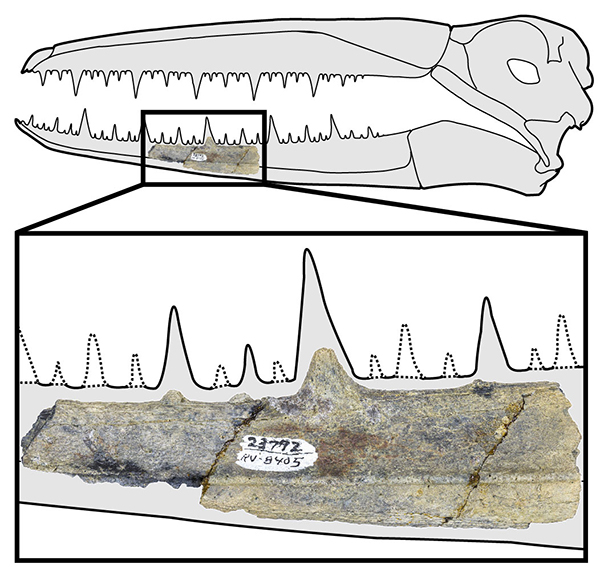
According to a study by scientists from the University of California at Berkeley and the Institute of Vertebrate Paleontology and Paleoanthropology (IVPP) of the Chinese Academy of Sciences, a 50 million-year-old fossil from Antarctica, belonging to an extinct group of ocean-going birds called pelagornithids, is thought to be the oldest record of truly giant flying birds.
Their study was published in Scientific Reports on Oct. 26.
The albatross-like pelagornithids are also known as 'bony-toothed' birds due to the unique bony spikes that resemble sharp pointed teeth on their saw-like jaws.
The fossils include a portion of the lower jaw near its middle with parts of the bony 'teeth' preserved which would have been up to 3 cm (1 inch) tall when the bird was alive. The ~12 cm (~5 inch) long preserved section of jaw came from a very large skull that would have been up to ~60 cm (2 feet) long. These fragments are proved to come from an individual as big, if not bigger than the largest known skeletons of the 'bony-toothed' bird group.
In addition, part of a foot bone from a different fossil locality on the island is the largest specimen known for the entire extinct group. Both fossils suggest the extinct species represented by the fossils had wingspans of between 5 and 6 meters (up to 20 feet).
"Today the wandering albatross with its nearly 3.5-meter (11.5-foot) wingspan is the largest flying bird. However, our fossil discovery with its estimate of a 5- to 6-meter (nearly 20-foot) wingspan shows that birds evolved truly gigantic size relatively quickly after the extinction of the dinosaurs, and ruled over the oceans for millions of years," said Peter Kloess, lead author of the study and graduate student at the University of California at Berkeley.
The researchers discovered that the foot bone actually came from a geological formation deposited nearly 50 million years ago. Its large size and extreme age make it the largest tarsometatarsus known of a bony-toothed bird and the oldest record of a giant-flier. The fragment of the jaw is from a different geological formation on the island laid down about 40 million years ago. The 10-million-year age difference between the fossils shows that these giant birds flew over the oceans around Antarctica for a very long time.
"The extreme giant size of these extinct birds is unsurpassed in ocean habitats. Only an extinct group of birds related to vultures, called teratorns, evolved wingspans close to what we see in these 'bony-toothed' birds. However in terms of time, teratorns come in second place with their giant size having evolved 40 million years after these pelagornithids lived," said Dr. Ashley Poust of the San Diego Natural History Museum, coauthor of this study.
This research documents that these extinct predatory large- and giant-sized 'bony-toothed' birds were part of the Antarctic ecosystem for over 10 million years, flying side-by-side over the heads of penguins swimming in the rich southern oceans.
Another coauthor Dr. Thomas Stidham from IVPP explained, "In a lifestyle likely similar to living albatrosses, the giant extinct pelagornithids with their very long pointed wings would have flown widely over the ancient open seas, which had yet to be dominated by whales and seals, in search of squid, fish, and other seafood to catch with their beaks lined with sharp pseudoteeth. The big ones are nearly twice the size of albatrosses, and these ‘bony-toothed’ birds would have been formidable predators that evolved to be at the top of their ecosystem."

Fig1. The lower jaw fossil of pelagornithids (Image by IVPP)

Fig 2. An illustration of pelagornithids (Image by Choo Brian)

86-10-68597521 (day)
86-10-68597289 (night)

52 Sanlihe Rd., Xicheng District,
Beijing, China (100864)

